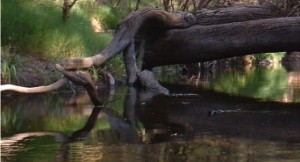The ecological roles of large woody debris in streams have been well documented. Fallen woody material acts as a source of energy and organic matter, increases the biomass of biofilms, periphyton, macroinvertebrates and fish, and influences substrate particle size and pool morphology. It also encourages mixing between surface water and groundwater, which creates local temperature variations in the sediment that can influence microbial and invertebrate growth and the spawning and development of fish. Researchers at the University of Texas used a 5 m long, 0.3 m wide tilting flume with a 70 cm-deep bed of coarse, permeable sediment and 11-14 cm diameter PVC pipes placed at right angles to the flow to replicate the effects of channel-spanning logs. Surface water temperature was controlled by a heating/cooling system and sensors in the flume recorded temperatures in the water above and below the sediment surface. Day-night fluctuations in surface water temperature ranged from 19 to 23oC. Immediately upstream of the simulated log, the presence of the obstruction forced water downwards and as a result the typical pattern of day-night temperature fluctuation was recorded deep in the sediment as well as in the circulating surface water. In contrast, immediately downstream of the log, water flowed upwards towards the sediment surface. Some of this upwelling water came from near-surface sediment and carried the fluctuating temperature signal, but the rest originated from deeper levels where water temperatures were much more stable. This meant that there was a sediment zone with large temperature fluctuations upstream of the log, and a different zone immediately downstream of the log where sediment water temperatures were stable even at shallow depths. In the downstream zone, the amplitude of daily temperature fluctuations showed an inverted pattern: at a sediment depth of 8 cm the amplitude was almost four times greater when a log was absent than when it was present, but at a depth of 33 cm the temperature amplitude was more than twice as great when a log was present. These results show that, by restricting the exchange of surface water and groundwater, the artificial removal of coarse woody debris from streams will tend to limit small-scale thermal variation in the sediment, and thus the diversity of stream microhabitats.
Original story at Freshwater Research News
Fresh findings from around the world, compiled and edited by Kev Warburton, Charles Sturt University

Sorry, the comment form is closed at this time.